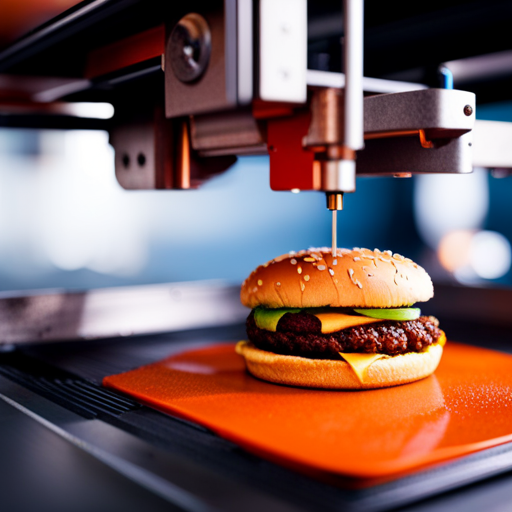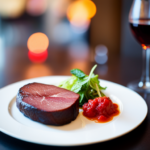Can technology revolutionize the way we consume meat?
In the quest for sustainable and ethical food options, 3D printing has emerged as a promising solution.
This article explores the innovative world of 3D-printed meat alternatives, delving into the evolution of this technology, its culinary and ethical implications, and the future possibilities it holds.
Join us as we uncover the art of 3D printing meat substitutes and its potential to shape the future of food production.
The Evolution of Meat Alternatives
Exploring the evolution of meat alternatives, advancements in technology and food science have revolutionized the way plant-based proteins are created and consumed. The emergence of 3D printing innovations has played a significant role in reshaping the landscape of meat alternatives. This disruptive technology has enabled the creation of plant-based protein products that closely mimic the taste, texture, and appearance of traditional meat products, thus appealing to a broader consumer base.
Furthermore, the meat industry disruption caused by these advancements has prompted a shift towards sustainable and ethical practices in food production. With 3D printing, manufacturers can precisely control the composition of plant-based proteins, allowing for customization of nutritional content and flavor profiles. This level of precision has led to the development of meat alternatives that not only satisfy the sensory expectations of consumers but also offer health benefits.
Understanding 3D Printing Technology
The process of 3D printing meat alternatives involves the precise layer-by-layer deposition of plant-based protein materials to create realistic and customizable products. This innovative technology allows for intricate customization of the composition and structure of meat substitutes, leading to products that closely mimic the texture, appearance, and even nutritional content of real meat. The 3D printing process enables the creation of meat alternatives with tailored characteristics, such as varying levels of fat content, marbling patterns, and even the incorporation of additional nutrients. This level of material customization is challenging to achieve using traditional food manufacturing methods.
| Advantages of 3D-Printed Meat Substitutes | |
|---|---|
| 1. Customizable composition and structure | 2. Efficient use of plant-based materials |
| 3. Ability to mimic the texture and appearance of real meat | 4. Potential for enhanced nutritional content |
Understanding the 3D printing technology behind meat alternatives sheds light on the potential for creating products that meet the diverse preferences and dietary requirements of consumers. It also paves the way for discussing the advantages of 3D-printed meat substitutes.
Advantages of 3D-Printed Meat Substitutes
The precision and customization capabilities of 3D printing technology enable the production of meat substitutes with tailored characteristics, allowing for efficient use of plant-based materials and the mimicry of real meat texture and appearance. This innovation brings forth several advantages:
-
Cost Efficiency: 3D printing meat substitutes can potentially reduce production costs by optimizing the use of ingredients and minimizing waste. The ability to create intricate structures and textures with precision also contributes to cost efficiency by ensuring that the final product closely resembles real meat, thus reducing the need for additional processing.
-
Taste Replication: With 3D printing technology, companies can precisely control the composition and distribution of flavors, enhancing the replication of the taste and mouthfeel of real meat. This allows for the customization of meat substitutes to meet specific flavor profiles and preferences, ultimately appealing to a wider consumer base.
-
Customization: 3D printing enables the customization of meat substitutes to cater to dietary restrictions, nutritional requirements, and even individual preferences, providing a level of flexibility that is not easily achievable through traditional meat production methods.
Culinary Creativity and Customization
Culinary creativity and customization manifest in the 3D printing of meat alternatives, allowing for precise tailoring of flavor, texture, and nutritional composition to meet diverse consumer preferences and dietary requirements. Customizable recipes are at the forefront of this innovation, enabling chefs and food technologists to experiment with a wide array of ingredients and formulations to create unique and tailored meat substitutes. This level of customization facilitates the development of products that cater to specific cultural cuisines, regional tastes, and individual dietary restrictions, ultimately expanding the appeal of meat alternatives to a broader audience.
Furthermore, the artistic presentation of 3D-printed meat substitutes adds another dimension to the culinary experience. With the ability to manipulate the appearance and structure of the final product, chefs can craft visually striking dishes that are not only delicious but also aesthetically pleasing. This aspect of customization opens up new possibilities for food presentation, allowing for the creation of intricate and visually captivating meat alternative dishes that enhance the overall dining experience.
As 3D printing technology continues to advance, the intersection of culinary creativity and customization holds significant promise for the future of sustainable and customizable food production.
Addressing Sustainability and Ethical Concerns
Addressing sustainability and ethical concerns is a crucial aspect of the development and adoption of 3D-printed meat alternatives in the food industry. As the demand for sustainable and ethical food production continues to grow, it is imperative for 3D-printed meat alternatives to address these concerns effectively.
Here are some key considerations in this regard:
-
Ethical Sourcing: Ensuring that the sourcing of ingredients for 3D-printed meat alternatives is ethical and humane is essential. This involves working with suppliers who adhere to ethical practices and standards in animal welfare.
-
Environmental Impact: Assessing and mitigating the environmental impact of 3D-printed meat alternatives is vital. This includes evaluating the energy consumption, waste generation, and overall carbon footprint associated with the production process.
-
Transparency and Accountability: Establishing transparency in the production process and holding producers accountable for their ethical and sustainable practices is paramount. Consumers should have access to information regarding the sourcing of ingredients, production methods, and environmental impact.
Future Possibilities and Innovations
As we look to the future of 3D printing meat alternatives, there are several exciting possibilities and innovations on the horizon.
One area of focus is the development of sustainable protein sources to support the growing demand for alternative meat products.
Additionally, the intersection of culinary creativity and 3D printing technology presents opportunities for the creation of unique and customizable meat alternatives that cater to diverse tastes and preferences.
Lastly, the potential health and environmental impact of 3D printed meat alternatives will continue to be a key area of exploration, paving the way for advancements in nutrition and sustainability.
Sustainable Protein Sources
Future possibilities and innovations in sustainable protein sources are shaping the way we approach food production, with promising advancements in alternative meat options like 3D-printed alternatives. As we look to the future, sustainable solutions and plant-based proteins offer exciting potential for meeting the growing global demand for protein.
Innovations in sustainable protein sources include:
-
Cell-Based Meats: Cultured from animal cells, these products offer a sustainable alternative to traditional meat production.
-
Algae and Seaweed: These marine sources are rich in protein and offer a sustainable protein option with minimal environmental impact.
-
Insect-Based Proteins: Insects are a highly sustainable protein source, requiring significantly less water and land compared to traditional livestock.
These innovations not only provide sustainable alternatives but also pave the way for a more environmentally conscious approach to protein production.
Culinary Creativity and 3D
The intersection of culinary creativity and 3D printing technology presents unprecedented opportunities for shaping the future of sustainable protein sources, offering innovative solutions to meet the growing global demand for protein.
3D printing innovation in the culinary industry has opened up avenues for creating intricate plant-based protein structures that mimic the texture and taste of traditional meat products. This plant-based revolution in 3D printing allows for the production of customizable and sustainable meat alternatives, catering to diverse dietary preferences and addressing environmental concerns associated with traditional meat production.
Chefs and food technologists are leveraging this technology to craft visually stunning and palatable plant-based dishes that were previously unattainable. As 3D printing continues to advance, it holds the potential to revolutionize the culinary landscape by introducing new dimensions of creativity and sustainability.
These advancements mark a significant step towards redefining the future of food production.
This culinary revolution not only holds promise for the future of sustainable protein sources, but also impacts the health and environmental implications of our dietary choices.
Health and Environmental Impact
The intersection of culinary creativity and 3D printing technology presents unprecedented opportunities for shaping the future of sustainable protein sources, offering innovative solutions to meet the growing global demand for protein. Leveraging this intersection, future possibilities and innovations in health and environmental impact through 3D printing meat alternatives are poised to redefine dietary choices and address sustainability concerns.
-
Health Benefits: 3D printed meat alternatives can be customized to contain essential nutrients, healthy fats, and reduced levels of saturated fats, offering a healthier alternative to traditional meat products.
-
Reduced Carbon Footprint: By utilizing 3D printing technology to produce meat alternatives, the environmental impact of traditional livestock farming can be significantly reduced, leading to lower greenhouse gas emissions and land use.
-
Innovative Ingredients: Future advancements may involve the incorporation of novel plant-based proteins and sustainable sources, further enhancing the health and environmental benefits of 3D printed meat alternatives.
Frequently Asked Questions
Can 3d-Printed Meat Alternatives Be Customized to Cater to Specific Dietary Restrictions or Preferences?
Customizable options in 3D-printed meat alternatives enable catering to specific dietary restrictions and preferences. This includes the ability to customize flavor and texture, offering a tailored experience that aligns with individual dietary needs and taste preferences.
How Does the Taste and Texture of 3d-Printed Meat Substitutes Compare to Traditional Meat?
When comparing 3D-printed meat substitutes to traditional meat, taste comparison and texture analysis are critical factors. The taste of 3D-printed meat alternatives can closely resemble traditional meat, while the texture can vary based on the production process and ingredients used.
What Are the Potential Environmental Impacts of Using 3D Printing Technology for Meat Alternatives?
The potential environmental impacts of using 3D printing technology for meat alternatives are significant. This innovative approach has the potential to reduce the environmental footprint of meat production by promoting sustainable production, optimizing the supply chain, and minimizing waste.
Are There Any Ethical Concerns Surrounding the Use of 3D Printing for Meat Substitutes?
Ethical considerations regarding 3D printing for meat substitutes encompass animal welfare, customization options, and dietary preferences. This technology raises questions about the treatment of animals, transparency in production, and the impact on consumer choices.
What Are Some Potential Future Innovations in the 3D Printing of Meat Alternatives?
Future applications of 3D printing in meat alternatives include personalized nutrition, enhanced texture and flavor replication, and sustainable production methods. Technological advancements in bioprinting and cellular agriculture may lead to more efficient and scalable meat substitute production.
Conclusion
In conclusion, the art of 3D printing meat alternatives has revolutionized the way we think about food. This innovative technology has paved the way for sustainable and ethical options that cater to individual preferences.
The possibilities for culinary creativity and customization are endless, shaping a future where meat substitutes are not only delicious but also environmentally conscious.
As we continue to explore this frontier, the potential for creating a more sustainable and ethical food industry becomes increasingly within reach.


